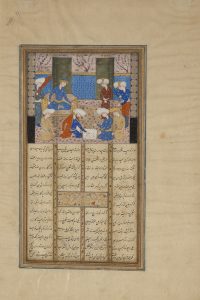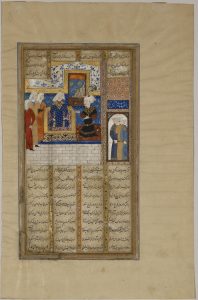Iran, Shiraz. Late 15th Century CE
Prince Meeting a Queen and Her Attendants
Folio from a manuscript of the Shahnama (Book of Kings) of Firdawsi (935-1020 CE)
Ink, opaque watercolors, and gold on paper
Gift of Elinor Lander Horwitz, class of 1950
SC 2016:29-18
This painting is from a 15th century manuscript of the Persian epic poem, the Shahnama or “Book of Kings.” Originally written by the poet Firdawsi in the late tenth century, it narrates several centuries of Iran’s history through mythical and non-fictional accounts.
This manuscript is illustrated in a style associated with the Aq Quyunlu or “White Sheep” Turkoman dynasty ruling in the city of Shiraz, Iran during the last third of the fifteenth century. Characteristics of this favored style include: a variety of decorative patterns and doll-like, apple-cheeked figures.
This folio page visually echoes the manuscript pages below through characteristics such as similar decorative borders, four blocks of poetic text, and use of vibrant color. However, there are slight stylistic differences in the depiction of figures and calligraphy, suggesting that these pages were produced and commissioned by different artists.
Beryl Briane Ford, Smith College ‘17


asd
Right: Iran, Shiraz. Late 15th century CE
Buzurgmihr Masters the Game of Chess
Folio from a manuscript of the Shahnama (Book of Kings) by Firdawsi (935-1020)
Ink, opaque watercolors, and gold on paper
Gift of Elinor Lander Horwitz, class of 1950
SC 2016: 29-19
Left: Iran, Shiraz. Late 15th century CE
Gushtasp Slays Rhino-Wolf
Folio from a manuscript of the Shahnama (Book of Kings) by Firdawsi (935-1020)
Ink, opaque watercolors, and gold on paper
Gift of Elinor Lander Horwitz, class of 1950
SC 2016:29-17
Prince Meeting a Queen and Her Attendants
[Detailed Image Description: This is a watercolor painting on paper with gold trim dated to the second half of the 15th century. The viewer looks into the scene, which is a viewing experience akin to looking at a comic book. In the upper top section of the page, there is an illustration that shows a seated queen with her three female servants standing behind her left shoulder. She greets a prince who kneels before her gesturing with his right and left hands up to say hello. His three male military companions stand outside of the room where the meeting is happening. The main scene takes place in an elaborate imperial Persian chamber that has blue and white floral wallpaper on the back wall near an opened window with a golden curtain. The queen and prince sit on two oriental rugs that extend horizontally across the painting from the left edge to the right edge. She sits on a large square raspberry pink pillow with gold trim and black floral designs, on top of a carpet rug that is a rich blue and is decorated with a white floral pattern. The prince sits on a smaller prayer rug that is red and decorated with a gold floral pattern. The queen sits upright with her legs crossed underneath her in a pretzel position and rests her hands on her knees. She wears a blue dress and an ornate gold necklace. Her female servants wear orange, red, and mustard colored dresses, each woman wears a white veil that covers their hair and extends to their shoulders. The prince wears a white turban with a large curved ostrich feather extending from the top center. His tunic is black with gold designs, and his sleeves are red. His male company wear tunics that are light blue, mustard yellow, and navy and hold their hands clasped together in front of them. They look into the scene like the viewer does as well but from the right-hand side of the scene. This illustration takes up a little less than half of the page. The other half of the page is Persian calligraphic text. Calligraphy is a type of decorative handwriting and Persian calligraphy is decorative handwriting written in the Persian language. There are four rectangular blocks of black text on the page that extend vertically from the top of the page to the bottom of the page. A gold border that has floral decoration frames each block of text.]
Buzurgmihr Masters the Game of Chess
[Detailed Image Description: This is a watercolor painting on paper with gold trim dated to the late 15th century. The viewer looks into the scene, which is a viewing experience akin to looking at a comic book. The painting shows eight men sitting or standing in a Persian imperial chamber. The attendants are shown standing, while the chess players and the prince are seated. In the center of the scene, two seated men play a game of chess, as their attendants who are seated behind them, and the other spectators watch. Every figure’s garments are richly decorated with gold patterns and each wears a turban on top of their heads. The men sit on an oriental carpet that is pink with small red flowers that extends horizontally from left to right. The wallpaper that decorates the space is blue with blue polka dots and trimmed with a gold band on the top edge. Two doors break up the wallpaper on the bottom of the wall. The top of the wall is decorated with pink wallpaper with black floral designs. This scene is located at the top of the page. The other half of the page is Persian calligraphic text. Calligraphy is a type of decorative handwriting and Persian calligraphy is decorative handwriting written in the Persian language. There are four rectangular blocks of black text on the page that extend vertically from the top of the page to the bottom of the page. A gold border that has floral decoration frames each block of text. In the center near the bottom of the page there is a title box that is decorated with red, blue, and white floral designs.]
Gushtasp Slays Rhino-Wolf
[Detailed Image Description: The title of this painting is Gushtasp, Slays Rhino-Wolf. The artist is unknown, and it is a watercolor painting on paper with gold trim dated to the late 15th century. The illustration is located at the bottom of the paper. It shows a soldier and his horse in a green meadow with four hilltops. A large oak tree stands on top of the middle hilltop, small purple flowers dot the grass, and the sky is a golden brown color. The soldier stands in the lower right-hand corner and is shown piercing a rhino- wolf in its side with his sword. The prince wears an ornate blue overcoat with a gold pattern, a gold helmet, and brown knee length boots. His horse is black and wears a green and gold overcoat with a saddle seat in the center of the seat. Accompanying this illustration, are four rectangular blocks of Persian poetry written in calligraphic font. The font is black, thin, and slanted. A gold border that has floral decoration frames each block of text. And in the center near the top of the page there is a title box that is decorated with red, blue, and white floral designs.]
